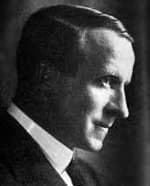John Buchan
Critique

Born
Perth, Scotland, 1875
Died
Montreal, Canada, 1940
Publications
Novels, history
Writing language
English
Literature
• The Thirty-Nine Steps (1915)
Novels
• The Thirty-Nine Steps (1915)
British Literature
• The Thirty-Nine Steps (1915)
Adventure
• The Thirty-Nine Steps (1915)
• Mr Standfast (1919)
Crime and Mystery
• The Thirty-Nine Steps (1915)
Thrillers
• The Thirty-Nine Steps (1915)
Of spies in an age of innocence
It's unfair maybe, but it's the way it goes. Writers who blaze trails that many other writers follow are often later neglected.
John Buchan was that sort of writer. Along with Erskine Childers (The Riddle of the Sands, 1903), he was among the creators of the modern espionage novel in the early twentieth century). Their works diverged those of other writers in which agents had existed as characters in literary novels focusing on personal relationships (see Joseph Conrad's The Secret Agent and Under Western Eyes, for example). Buchan was one of the founders of the thriller with the spy chase at the centre of the narrative. The espionage thriller developed further in the hands of later writers like Eric Ambler (The Mask of Dimitrios, 1939), Graham Greene (The Third Man, 1939), Ian Fleming (Casino Royale, 1953), and John le Carré (The Spy Who Came in from the Cold, 1963).
A typical early story features an innocent civilian who gets caught up in international intrigue and uses his native smarts to outwit the villains, usually anarchists or mercenaries in the pay of foreigners. Eventually these plucky characters give way to more sophisticated fellows, and eventually to professionals in the official intelligence services. A cynicism about morality in espionage comes to the fore and a common plot now involves anti-hero agents questioning whom they can trust—and whether they are working for good at all.
A simpler time
This progression in the genre can leave older works seeming naïve and old-fashioned. When we look back on John Buchan's novels, they seem somewhat corny. Only one of his long list of publications is still regularly read these days—and not even as much as several decades ago when The Thirty-Nine Steps used to be on school reading lists.
But if you can put aside your jaded modern attitudes, some of his works can still be quite diverting. They give you a picture of a simpler time, while revealing unintentionally the dark fears and prejudices below the blithe surface. They also show you the roots of the contemporary thriller: the galloping plot, the quickly sketched characters, the gradually complicated storyline, the unravelling from unawareness to shocking revelations to acceptance to doubts to new shocking revelations. And they can still grab and hold onto your attention. They're still page turners.
Buchan was born in Perth, son of a Free Church of Scotland minister. He was raised and educated in Scotland until attending Oxford. As a stand-out student he published five books, mainly nonfiction but including the novel Sir Quixote of the Moors (1895). He later became a barrister and a secretary to the High Commissioner of South Africa, out of which experience came his first popular novel, Prestor John (1910).
He returned to England and while sick in bed during the first months of the First World War he composed his most enduring novel, The Thirty-Nine Steps (1915). The story with its fast-moving plot and thrilling suspense was a hit and has been made into a film several times, most notably by Alfred Hitchcock in 1935. It's also been a successful play, staged on both sides of the Atlantic repeatedly and most recently on Broadway about a century after the novel was first published.
The books led to four more novels in the series, three of them with the same stalwart hero, Richard Hannay: Greenmantle (1916), Mr Standfast (1919), The Three Hostages (1924) and The Island of Sheep (, also known as Man from the Norlands, 1936).
Buchan was a Conservative Member of Parliament from 1927 to 1935 at which time he was created the First Baron Tweedsmuir of Elsfield and named Governor General of Canada, a position in which he served until his death.
Among his other writing—including histories, biographies, stories and political essays—Buchan produced two other popular adventure series. Dickson McCunn is a retired Glasgow grocer caught up in intrigue in Huntingtower (1922), Castle Gay (1930) and The House of the Four Winds (1935).
Lawyer Edward Leithen is featured in The Power-House (1916), John MacNab (1925), The Gap in the Curtain (1932) and Sick Heart River (also known as Mountain Meadow, 1941)—a series which has recently been republished in a single volume.
Since Buchan's heyday, most of his well-crafted works have been forgotten by the general public. His early espionage adventures—once exciting but now seeming left behind by the genre they helped invent—are best remembered, with only one of those being read at all today.
— Eric
Critique

